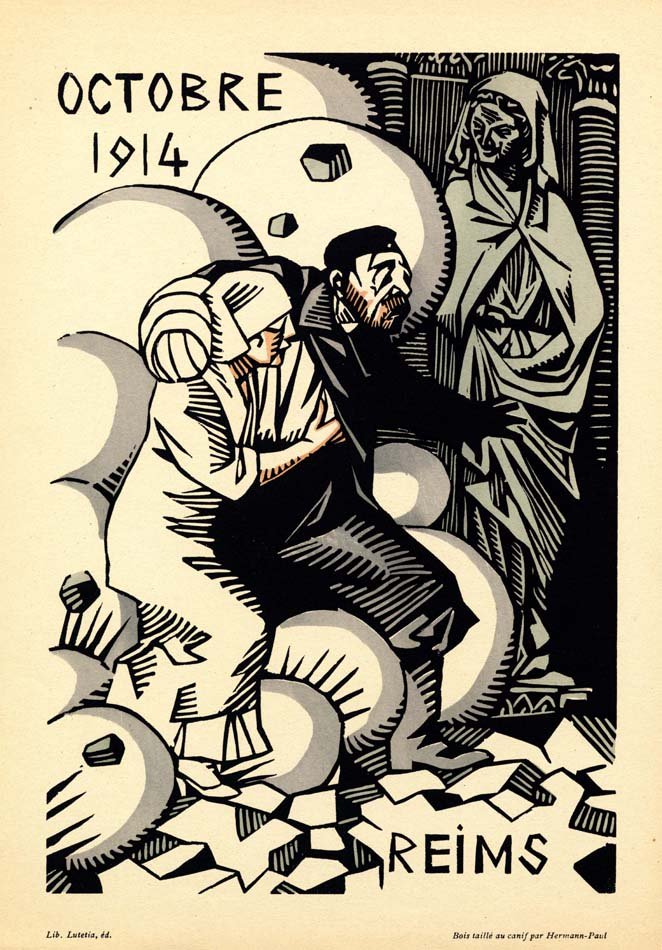The War Between Covers
A number of portfolios were issued that deal, exclusively or in part, with the conflict. Their exact uses remain unknown. Smaller than most posters, some may have hung on walls or in windows. Many featured eye-catching color and bold shapes. Whether displayed publicly or viewed privately, each offered a perspective on the struggle.
On loan from a private collection.
The bombardment of Reims Cathedral began in 1914 and continued through 1917 with one brief respite when the Germans occupied the town for several days. Contemporary French opinion held that the Germans purposely aimed at the cathedral, the traditional site of French coronations. This example of German barbarism became a major propaganda theme. Postcards from 1914 already document the damage. The woodcut by Hermann-Paul depicting October 1914 shows an injured soldier being helped from the exploding rubble by a nurse. The Smiling Angel from the central portal of the facade, a symbol of the cathedral, looks on beatifically.
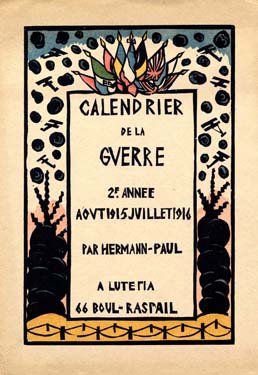
On loan from a private collection
It was probably a broader French optimism about the length of the war that motivated several artists to begin calendars of the conflict. But after the completion of this second portfolio in July 1916, Hermann-Paul, his publisher Lutetia, or both, lost heart, and the enterprise was ended. Like the first portfolio cover, this wrapper is decorated with emblems of military might: airplanes, exploding bombs, and the flags of the Allies. The color is more vivid than the first with a light yellow background, dominated by white smoke from single canons flanking the text. Lutetia issued a great many works related to the war.
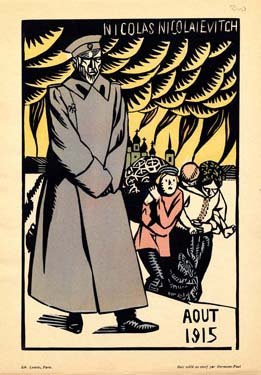
On loan from a private collection
The sheets of Hermann-Paul's second portfolio establish a chronology of the war through depictions of a series of commanders. These stand proudly in the foreground, while the background alludes to events of the conflict. Grand Duke Nicolas Nicolaievitch, commander in chief of the Russian armies on the eastern front, is resolute, while citizens flee a burning city, carrying their children and their belongings on their backs. An onion-dome church will fall victim to the flames. This may refer to the Sventiany offensive of August 1915, when the German army launched an attack against the Russians, who ultimately triumphed in the battle.
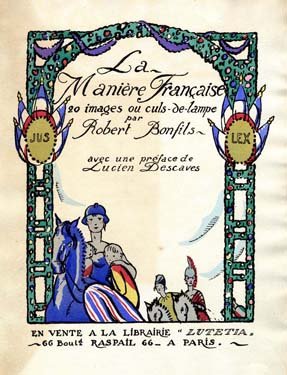
On loan from a private collection
The twenty sheets of this portfolio are housed in an elaborate decorated folder. On its cover La belle France rides through foliate flowering arches astride a horse, clothed in the tricolore and wearing the blue metal Adrian helmet, named for its designer, August-Louis Adrian, and introduced by the French in 1915. The allies later adopted a version of it. Extravagant endpapers enclose the whole; decorated with red, white, and blue round roses, an exploded cocarde, and bearing the words "Vive la France," the portfolio is also tied with tricolor ribbons. On the similar cover sheet, France shelters two children clothed in the Belgian flag.
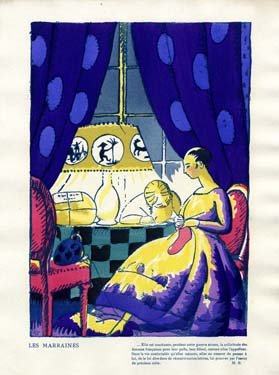
On loan from a private collection
Marraines, or "godmothers," were women pen pals for soldiers in a program encouraged by the French government. Over the course of the portfolio, Bonfils varied the color palette of the sheets of La manière française. This nighttime scene creates dramatic shadows. Framed by extraordinary purple polka-dotted curtains, the marraines knit socks and write letters to "their poilu, their godson," as the text explains. A "precious parcel" is already addressed, ready to send to the front. They work by light shaped by a lampshade decorated with silhouettes. Prominent is a man in a Chinese hat under a tree. Bonfils created a similar scene for the representation of China in the portfolio Les hymnes alliés.
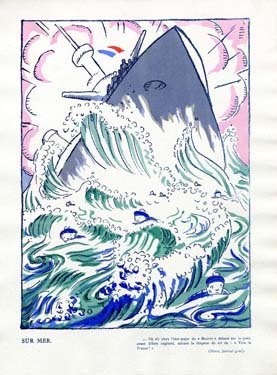
On loan from a private collection
On March 18, 1915, the French battleship Bouvet was engaged in an attack on a Turkish fortress in the Dardanelles when it was struck by shellfire eight times; the ship then hit a mine and sank. Only about 50 men of 710 were saved. Bonfils depicted the drowning sailors behaving in an appropriate manière française. The ship, surmounted by the tricolore, dominates the composition. As the text accompanying the illustration reports, the officers stood on the bridge, saluted the flag and cried, "Vive la France!"
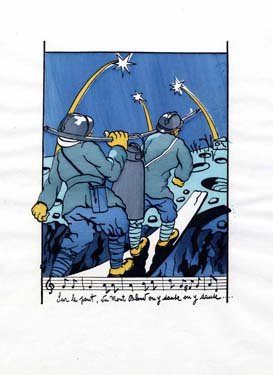
série
On loan from a private collection
The often chilling iconography and ironic use of nursery songs in this portfolio seems unsuitable for its stated audience of children. Here the site is transposed from the 15th century bridge in Avignon to a makeshift one constructed from a plank spanning a trench in a pockmarked battlefield. Two French infantrymen carry munitions across its precarious span while bombs burst in the sky. The left arm of the nearest soldier breaks through the frame of the picture into our own space, rendering the scene especially immediate. The original song contains a reference to the military: in the third verse soldiers are instructed to salute, perhaps one more caustic allusion on the artist's part.
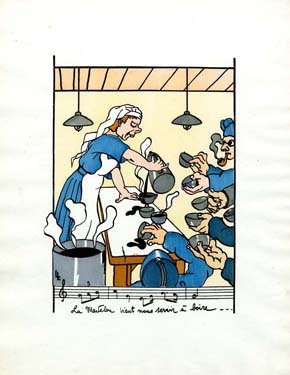
Louis Lefèvre. Rondes glorieuses. [S.l.: s.n., n.d.]. 2ème série
On loan from a private collection
By the time the second series of Rondes glorieuses was issued, the soldier on the cover, presumably Lefèvre, had earned a seventh stripe. As before, the sheets primarily feature traditional children's songs that sardonically comment on the war. The lyrics of "Mon bon château," for example, describe the destruction of the "good castle," in Lefèvre's sheet a crude shelter obliterated by a shell. This page highlights a new tune and lyrics by Louis Bousquet and Camille Robert (1914) that became a popular war song, "La Madelon." Here, the object of desire, the comely tavern waitress Madelon, is transformed into a server in the mess. Her principal attraction is the coffee she dispenses.
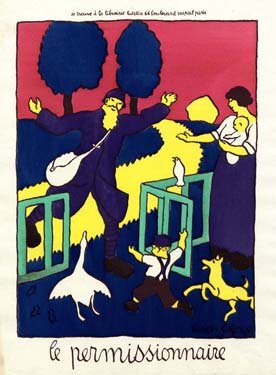
On loan from a private collection
Lutetia published a great many prints related to the war off the battlefield, including a portfolio of six by Lucien Laforge. In the sheet Le permissionnaire every creature moves toward the open gate to welcome the title soldier home on leave, as he runs with open arms to the son rushing towards his embrace. His wife and baby and even the dog, duck, chicks, and bird join in the reception. Once again Laforge employed an astonishing palette, this time of bright pink, royal blue, purple, vivid yellow, and green.
